Marcia Thornton Jones's Blog, page 7
May 11, 2025
It's All in How You See It
 Growing up with a professional artist as my dad granted me the privilege to see things differently than most people might. Take the blanket of snow on a hillside we were passing. “See that? See how blue it appears? If I were to paint it that color, no one would believe me.” I saw it. I believed him.
Growing up with a professional artist as my dad granted me the privilege to see things differently than most people might. Take the blanket of snow on a hillside we were passing. “See that? See how blue it appears? If I were to paint it that color, no one would believe me.” I saw it. I believed him.Then there was our roadtrip to the Grand Canyon. Did my dad drive directly to any old vantage point? Of course not. He drove, stopped, got out of the car, took a look, then drove on. Once. Twice. Three times. On the fourth, he parked for real but had us promise we’d keep our eyes shut as we walked. "Open them," he finally said.
The overwhelming, ever-expansive, panoramic depth. How many people are privileged to first see such a sight from that perspective? I can still feel the awe. In fact, I wish I could lead you there myself.
The best I can do, though -- strive to do -- is to bring moments like that to my readers, moments that no one sees coming.
May 8, 2025
PERSPECTIVE by Jane Kelley
Has this happened to you? After you share your misery with a friend, they say something like -- reframe the narrative. It's all in your head. You can't change your situation. but you can change your attitude.
Yes. I have been that friend. I've also been that author. I do believe that advice has some merit. But perspective isn't just your mental view. Sometimes perspective is your actual view.
My sister, my husband, and I went for a hike. We found this hollow log that was the perfect size to crawl through. So my sister did.
Inside the log, it's dark and full of spiders. It's small. You can't walk proudly upright. You have to crawl. And while you're on your hands and knees, other people are enjoying a beautiful sunny day.
 Judging by her expression, my sister seems to be rethinking this choice.
Judging by her expression, my sister seems to be rethinking this choice. 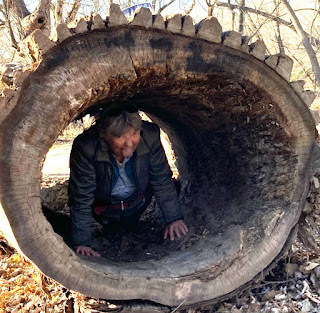 Eventually she escapes from the tunnel and returns to the light.
Eventually she escapes from the tunnel and returns to the light. The point is pretty obvious. It's better to be in the sunshine than in a dirty log. There is another point -- to me.
The point is pretty obvious. It's better to be in the sunshine than in a dirty log. There is another point -- to me. Sometimes we actually are someplace unpleasant. The dirty log is a real place. My sister chose to pass through it. Usually the difficult places are not optional.
As a writer -- and as a human, I have to acknowledge the difference.
JANE KELLEY confesses to deliberately putting her characters in tight spots. She hopes they have forgiven her.
May 2, 2025
Middle Grade Fiction for May
Over the past couple of weeks I've interviewed some authors of new middle grade novels for my blog, Book Q&As with Deborah Kalb, and I thought I'd share a little of what they had to say!
 M.M. Downing and S.J. Waugh are the authors of the new novel Berlin Breakout, the third in their Adventures of the Flash Gang series, which takes place in the 1930s. They said: "It is important to repeatthat what surprised us when writing these books is how timely this story is.The rise of fascism, the fracturing of alliances, authoritarian rule, jobinsecurity, the widening gap between wealth and poverty in the 1930s is aharbinger of some of the struggles we see today. We began this taleimagining a period romp of orphans and car chases and murky alleys. It becameso much more."
M.M. Downing and S.J. Waugh are the authors of the new novel Berlin Breakout, the third in their Adventures of the Flash Gang series, which takes place in the 1930s. They said: "It is important to repeatthat what surprised us when writing these books is how timely this story is.The rise of fascism, the fracturing of alliances, authoritarian rule, jobinsecurity, the widening gap between wealth and poverty in the 1930s is aharbinger of some of the struggles we see today. We began this taleimagining a period romp of orphans and car chases and murky alleys. It becameso much more."
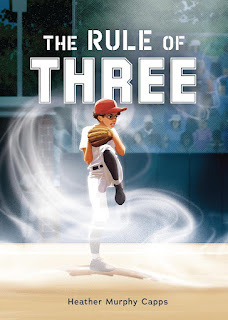 Heather Murphy Capps' novel is called The Rule of Three. She said of her character Wyatt, "When I created Wyatt’s character, my goal was to tellthe story of a person who has a genetically inherited trait that is a result offamilial trauma. However, it was important to me to show the wholeperson, not just the trauma—which is why we get a chance to see Wyatt’s friendshipsand his love of baseball. At its heart, this is a story about family,friendship, and baseball as much as it is about trauma."
Heather Murphy Capps' novel is called The Rule of Three. She said of her character Wyatt, "When I created Wyatt’s character, my goal was to tellthe story of a person who has a genetically inherited trait that is a result offamilial trauma. However, it was important to me to show the wholeperson, not just the trauma—which is why we get a chance to see Wyatt’s friendshipsand his love of baseball. At its heart, this is a story about family,friendship, and baseball as much as it is about trauma."
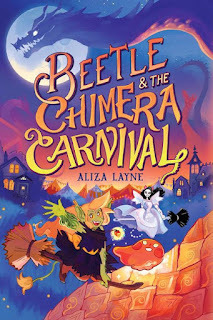 Aliza Layne is the author and illustrator of the graphic novel Beetle & the Chimera Carnival, the second in a series. I asked if she worked on the text or the illustrations first, or both together, and she said, "Both simultaneously! Because I’m both writing and drawing, it might be easierto think of the situation like a movie where I am able to do a vast number ofjobs. Ihave to think like a screenwriter and put the story together; I have to thinklike a director and stage the shots; I have to act as the characters by drawingtheir performances, and I have to think like the art director and style thecharacters and design the locations. It’s a lot of work, but it really is fun."
Aliza Layne is the author and illustrator of the graphic novel Beetle & the Chimera Carnival, the second in a series. I asked if she worked on the text or the illustrations first, or both together, and she said, "Both simultaneously! Because I’m both writing and drawing, it might be easierto think of the situation like a movie where I am able to do a vast number ofjobs. Ihave to think like a screenwriter and put the story together; I have to thinklike a director and stage the shots; I have to act as the characters by drawingtheir performances, and I have to think like the art director and style thecharacters and design the locations. It’s a lot of work, but it really is fun."Happy reading!
--Deborah Kalb
April 30, 2025
Interview with Jacqueline Davies, Author of The Lemonade War

Welcome to Smack Dab,Jacqueline! Congrats on the release of the graphic novel adaptation of yourmuch-loved Lemonade War. Please tellus (or, more likely, remind us) about the story in The Lemonade War.
Thanks! I’m so happy to be here and have the chanceto talk about a story that is near and dear to my heart. In the original Lemonade War—and now in the graphicnovel adaptation—brother-and-sister Evan and Jessie get into an argument aboutwho can raise the most money selling lemonade in the five days before schoolbegins. What starts out as an innocent bet between siblings soon becomes afull-blown, winner-take-all war. Marshalling troops, drawing up battle plans,and dirty tricks all play a part in the competition. Will Evan and Jessie finda way to end the war? And will they come to understand that what they’re really fighting about is much biggerthan a lemonade stand?
How did the idea for thisadaptation come about?
Years ago, my editor and I were talking about the newtrend of adapting well-known middle-grade novels into graphic novels. We foundit fascinating. How could such a thing be done?? As an author, I tried toimagine the process, and it seemed incredibly difficult. I suppose I likethings that are difficult—or at least challenging and new. A few years later,when an author friend told me about a 4-day workshop on writing a graphicnovel, I decided to attend. That was my first true glimpse into the intricaciesof writing a graphic novel, and I decided then that I wanted to try adapting The Lemonade War into a graphic novelscript. I didn’t know if I could do it, but I wanted to try. So, the adaptationreally began as a writing challenge to myself.
As authors, we just cannotstop editing. What was it like to revisit your novel? Any desire to revisecertain plot points?
What a great question! I actually had to fight theopposite impulse in the process of adapting the novel to the graphic form.Because I was a complete beginner, I clungto the original version of the story the way a person washed overboard clingsto a life preserver. I didn’t want to change a single thing. If I did, I feared I’d lose my grip and sinkunderwater. And so I found myself simply transferring the dialog, every word ofit, and importing each action, every shrug of the shoulders or roll of the eyes,without altering a thing. About fifty pages in, I realized this wasn’t working!The story, faithfully transcribed from its original form, was too slow andponderous in the graphic novel form. That’s when I started to loosen up. Theplot of the story remains the same, but I gave up trying to carry everythingover.
What was the process likeof adapting this storyline into a visual art form?
I knew it would be hard, and I was right! The mostchallenging part for me was managing the pacing of the story. When my editorreturned the first draft of the script to me with her comments, they were all about combining panels: Could thesetwo panels be combined into one? Could these three panels be combined? Whatabout these four? Her revision comments were a master class for me in how tokeep the action moving forward in a visual medium. I’m good at pacing mymiddle-grade novels. But keeping things moving in a graphic novel, while stilltelling a story that has nuance and depth—that’s a set of skills I needed tolearn.
After a while, I put my editor’s comments aside andcontinued the revision on my own. It’s like I’d been given a special pair ofglasses that allowed me to see something that was invisible to me before. Icould see all that could be accomplished in a single panel: back-and-forthdialog, changes in emotion, sequential action, and the passage of time. I cuteighty pages out of that first script, just by tightening up a little here anda little there and by pushing against the limitations of each single panel. Itwas a revelation!
The Lemonade War has become a much-relied-on teaching tool tointroduce young readers to basic economics. Have the economics lessons changedat all around the core story as the economy has gone through both good and badtimes?
You’re so right that the book has been used to teacha wide range of subjects in the classroom—and that is entirely due to thecreativity and energy of teachers who have sought out ways to integrate readingwith other disciplines. I put the “economics” in the book because as a child I was very interested in earning moneyand that seemed like it would be a central interest of Jessie’s. All thanks goto the teachers who took that childhood interest of mine and turned it intolesson plans that are highly engaging and multidisciplinary. As for the lessonschanging with the economic winds—I don’t think so. The lessons taught arefoundational: supply and demand, profit margin, negotiation. These basic tenetshold in all economies.
The novel also deals withsome complex emotions between siblings–jealousy, competitiveness, etc. Werethere any emotional parts of the story that were illuminated in new ways by newvisual aspects?
One of the most intriguing and fun aspects for me interms of writing the script was how to handle the metaphors in the book. Thereare two in particular that posed exciting opportunities for using the visualsto convey emotion.
In Chapter 1 of the original book, Evan is angry atJessie, and he’s trying really hard not to say all the mean things he’s feelinginside. The pent-up words feel like bats inside his chest, beating their wingsin an attempt to escape. In the graphic novel, we were able to show the bats!We see them bumping inside Evan’s t-shirt; we see a wing appear as one batescapes and then another. In the final page of the chapter, the full-page panelis filled with swooping, out-of-control bats and Evan’s angry words superimposed:“I hate you!” It’s a really powerful way to show the character’s emotion, andit’s a way that couldn’t have been done in the original telling.
Another emotional metaphor in the original proseversion of the book is that Jessie, at times, has a nagging feeling that keepstapping on her shoulder. In the graphic novel, we were able to personify thenagging feeling as a little purple blob that cannot be gotten rid of. Jessie brushes the blob off her shoulder,shakes it away, and even inadvertently flings it across the room. No matterwhat, the purple blob finds its way back to Jessie’s shoulder where itcontinues to tap, tap, tap at her thoughts.
Love the ten tips at theend for turning lemons into profit–but really, it could be advice on turning aprofit on any product. Have you heard stories of young entrepreneurs who wereinspired by The Lemonade War through the years?
Yes! Oh, many times. And again, I owe so much toteachers and librarians who have gone the extra mile to help their studentsenact some of the money-making tips. Many classrooms read the book and thenhave lemonade stands, often with some kind of competition. In this way, kidsfollow the story in real life, doing the things that Evan and Jessie do:collaborating, planning, working, and seeing the fruits of their labor resultin profits. There is no better way to get a reader to engage deeply with a bookthan to have that reader take physical action that mirrors the story.
But there are all kinds of entrepreneurship that havebeen sparked by the book. I’ve met kids who have made and sold home-made comicbooks. One group of girls beaded friendship bracelets and sold them. Anotherreader made origami frogs and sold those. My own daughter made a “lemonade”stand selling dog blankets she had made. Kids everywhere are interested infinding ways to earn money.
One of the biggest lessons, though, centers aroundwhat do you do with your money once you’ve earned it. Jessie likes to save.Evan likes to spend, sharing generously with his friends. And Megan chooses togive her money to charity. It warms my heart every time I read a newspaperarticle or see a local TV news clip or hear from a classroom about kids readingthe book and then raising money for a charity: a local animal shelter, a seniorcenter, their town library, or a family in their school community that’s goingthrough a tough time. Sometimes they give to a national organization, likeAlex’s Lemonade Stand Foundation, which raises money for pediatric cancerresearch. Big or small, local or national, it’s so important that we teach ourkids—through experience and doing—that caring for each other and ourcommunities is the greatest thing we can do, and that every one of us has thepower to make a real difference.
Do you feel as though anyof the math and business concepts have actually been explained in new ways bythe visual version of The Lemonade War?
Actually, there were a good number of drawings (someof them done by me!) in the original book that helped explained the math thatJessie and Evan were doing in the story. Those drawings were brought forwardinto the graphic novel version, but beautifully redrawn by the extraordinarilytalented Karen De la Vega. Karen’s illustrations throughout the book bring newlife to every aspect of the story. She’s so talented, and I feel very luckythat she agreed to illustrate this book.
My favorite part of thisstory is the idea that competition can both motivate and divide. What inspiredyou to include collaboration as a theme? Was this always part of the vision ofthe novel?
From the beginning, I wanted to write a story thatshowed there are two sides to every argument. That’s why, in the original book,the chapters are told from alternating points of view. The first chapter showsus what’s going on in Evan’s head and heart; the second chapter shows us whatJessie is thinking and feeling; and back and forth. For this reason, I wantedthe two main characters to be very close and collaborative (a brother andsister who usually get along really well), but I wanted them to be opposites.(Evan is good with people, while Jessie struggles to understand people; Jessieexcels in academics, while Evan has trouble keeping up in school.) I’ve longbelieved that the people we love the most can lead to the most explosivedisagreements! And once you find yourself in the middle of a war, how do youfind your way back to the place of love?
What’s next? Anyadditional graphic novel adaptations on the horizon?
At the moment, I’m working on another middle-gradenovel. But I would love to try my hand at writing the graphic novel script forthe second book in the series, TheLemonade Crime. I guess we’ll wait to see how the first graphic novel doesin terms of sales! If readers like that one, then we might do more. I also havean idea for an original graphicnovel, and I would definitely like to take on the challenge of writing thatscript.

You offer presentationsand virtual visits. Where can educators or young readers get in touch with youto request a visit or share their experiences with The Lemonade War?
Educators and readers can reach me in any of thefollowing ways:
Website: www.jacquelinedavies.net
Instagram: @jacquelinedaviesbooks_
YouTube: @jacquelinedavies9
Blue Sky:@jacquelinedavies.bsky.social
And please sign up for mynewsletter!Every month, I share news about my books and give away free books to educators. You can sign up here:
https://www.jacquelinedavies.net/landing-pagesignup
~
ABOUT JACQUELINE DAVIES
Jacqueline Davies is the bestselling and award-winning author of books for children and young adults, including The Lemonade War series, the Sydney and Taylor series and more. Her books have sold more than 2 million copies and have been selected as an ALA Booklist Editors’ Choice, Bank Street College Best Children's Book of the Year. She divides her time between a town just outside of Boston and a cabin on the wild coast of Maine. In addition, she almost always has a suitcase that is in the process of being packed or unpacked.
April 29, 2025
Two Negatives DON'T Make a Positive....
by Charlotte Bennardo
The theme is "negative space." And my pic:
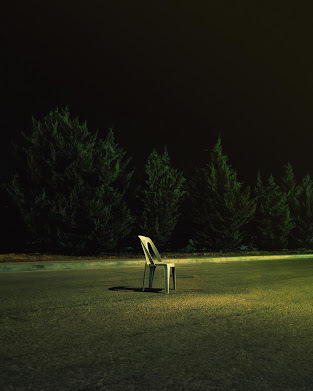 Photo by Plastic Lines: https://www.pexels.com/photo/a-chair-...
Photo by Plastic Lines: https://www.pexels.com/photo/a-chair-...Okaaaay, so I have a chair, in a field. And you're probably guessing that the space around the chair is the negative space.
No.
That space is filled with grass, trees, sunlight, a chair. The negative space is that chair is empty, it's not utilized in its function. There's a space that shouldn't be there, someone should be sitting in that chair.
But it's empty. It's a negative.
Like... the space that should have been occupied by my post last month. I'd forgotten to draft it and had gotten caught up in life, my new book, marketing, a foot problem, going on vacation, wondering about opening my pool, etc., etc. You know the excuses.
That created the empty space; my words should have been there. A picture. Instead, I'm sure others (probably Holly Schindler, blog creator/owner, friend) picked up the slack.
It was my space to fill, like I do every month, and I didn't. Not being where we're supposed to be or doing what we're supposed to do, creates a negative space, whether it's writing a promised monthly post, meeting someone on time, or doing something we said we'd do. When we leave that unexpected space, it creates negativity. Why didn't Charlotte do her post? Who can fill in the negative space? What will someone else have to give up in order to fill that space?
Looking back, I see my February post, most likely due to my error, didn't post- it still says Draft. That left another empty space. To partly atone, I am posting that as well.
I hope I will leave no more empty chairs in this space.
Char
Charlotte writes MG, YA, NA, and adult novels in sci fi, fantasy, contemporary, and paranormal genres. She is the author of the award-winning middle grade Evolution Revolution trilogy, Simple Machines, Simple Plans, and Simple Lessons. She co-authored the YA novels Blonde OPS, Sirenz, and Sirenz Back in Fashion. She has several short stories in the various anthologies. Having finished her MFA, she's applying what she learned and is working on several children's and adult novels, and other short stories. She lives in NJ with her family and floofy cat. When they trimmed the backyard tree, the crazy squirrel couple had to move out, but she is happy to report she has a new squirrel tenant along with a pet rabbit (Bad Bunny).
April 28, 2025
Interview with Aliza Layne, Author and Illustrator of Beetle and the Chimera Carnival

Please tell us about Beetle & the Chimera Carnival.
This book is the second in a trilogy that starts with Beetle and the Hollowbones, a storyabout a young goblin witch trying to rescue her best friend, a ghost who isbeing forced to haunt the mall. To do this, Beetle has to enlist the help ofKat, her previous best friend who moved away to attend a prestigious andexpensive school of magic. I really recommend reading that book first!
Beetle and the ChimeraCarnival is the second book. It follows all threecharacters again after they discover a dragon, injured and close to death, onthe vacant lot where the mall once stood. How did this happen? Why are all thedragons disappearing? Beetle wants to get to the bottom of it, but her latentmagic is going haywire. She’s turning into a monster. Those two things couldn’tpossibly be connected… could they?
This is the book where I will teach you how skeletons get born.
Nothing draws me into a book faster than humor. The bitabout the blob ghost whose undead heart was a penny in a mall fountain had melaughing right on page 1. Humor can be really hard, though. How do you tap intothat humor? Or is it part of your natural voice?
The joke you’ve just described has been a central part of the plot ofthis series for so long that I actually completely forgot it was funny at all!
Humor evolves naturally when you’re talking. I’m lucky to have a lot ofpeople around me who enjoy doing that, being funny together with each other asour audience. Writing a story is also a game of communication, so I’m thinkingabout what the kids reading will find funny or emotional or cool. Even thoughmaking a book is rather one-sided, I can’t talk back or clarify what I’m sayingto the reader either if they’re confused, so I have to be careful. And I dolike it when I get to have a real conversation because of the book at authorevents. I’ve met some really wonderful people that way!
As a child of the ‘80s, I loved the fact that this tookplace at the site of an old abandoned mall. How’d you come to choose it as thesetting?
I was a mall employee at a bookstore from 2014 to about 2018, and somenights I used to leave after the mall was closed and all the lights were off. Iwould walk out of the weird little labyrinth of the mall alone but I wasn’t theonly thing making noise. In the distance, down the corridors, I could hear thearcade games and claw machines calling out in their recorded voices, likelittle ghosts.
And here’s the strangest part—a few years after I left and the firstBeetle book was published, the bookstore I’d worked at was bought out. And theperson who bought it opened a haunted house. A year-round haunted house in themall! I’ve never been inside because it’s always closed. I don’t know why thathappened! Why did that happen?!
I was struck by how much movement is in the panels–flying,falling, even the POV shifts where we’re looking up at buildings from below ordown at rooms from the ceiling. How did you plan out the action?
I’ve spent a lot of time studying comics and films as well as justmaking comics, so I’m really doing it intuitively at this point. Luckily, theonly thing preventing me from getting the shots I want to get is my own drawingability. When I look down on rooms like that, I often use a 3d program tocompose references for the shot before I draw it. That way I can plan the spaceso that it works perfectly for what I need, but I also have the freedom to puta camera there as if it were real and find new shots.
Action is difficult to compose, but the primary thing is being able tounderstand what’s happening, so I try to write and draw with clarity in my mindfirst. I think there’s still lots of ground for me to gain there!
I know this is a sequel. How hard was it to balance tellingthe backstory for new readers and not giving too much for readers familiar withthe characters?
I wrote out all the most successful sequels I’d seen done and actuallyhad pretty much all the same criteria in my mind as in this question, and thesequel that stood out to me was Shrek 2. I figured it did a huge amount of thethings I needed to do, so I studied its structure and tried to understand whyit worked. This method comes at a high recommendation from me! I think itworked!
This story weaves together necromancy, dragons, and manymagical elements. How did you approach balancing these different supernaturalaspects while keeping the story cohesive?
Halloween-themed anime and manga like Sugar Sugar Rune, Soul Eater, and Little Witch Academia certainly influenced my idea for a Halloweenfantasy series. Halloween is a holiday that has never lost its magic for me andI think it’s because everyone is encouraged to play, even adults. So I wantedmy ideas for how magic would work to come from that feeling of playing. Butmore than anything, the lore is built for a purpose: to tell the story I’minterested in telling. The story always comes first.
As a writer who recently got back into art myself, I'mcurious about your character design process. How do you develop the visualelements of your characters, especially considering how clothing seems to playsuch an important role in their identities?
That’s exciting! I really wish you the best with drawing, I personallylove it a lot and am self taught.
What I think about most when I’m designing characters is whether they’regoing to be able to do what they need to do, like whether they can give abelievable acting performance. That’s why Kat looks less like a skeleton thanall the other skeleton characters, because her model needs to be able toperform tons of different kinds of acting. Unfortunately, everyone tells methat Kat is very hard to draw, and I agree. I often don’t get her right andhave to try again. Making her that way was goofy of me but I like how uniqueshe looks.
I decided early on to make sure the characters wore different outfitsbecause of how much I enjoyed it in SailorMoon. It allows you to show so much about who the characters are!
I was struck by how the story emphasizes that witchcraftisn't about innate talent but work and practice. Was challenging the concept ofnatural talent an intentional theme from the start? What other ideas do youhope readers take away from the book?
Witchcraft is separated from the other talents to make the readerinitially question its legitimacy, which they’re invited to do along withBeetle in book one. We also establish that sorcery has gained dominance withinculture as the kind of “real” magic academics use. In book two I contrast thisagainst the other two types of magic in the setting, necromancy andtransformation, and talk about what complicates them, especially becausetransformation magic is innate andnecromancy calls into question the concept of “natural vs unnatural” creatures.In book three, you will find that this exploration is building to a thesis, sothat’s all I’ll say about that for now.
The coming out party at the end features some of the mostcolorful and vibrant panels in the entire book. Could you talk about how youapproached this scene of self-acceptance and its importance to the overallstory?
Thank you! In both this scene and the scene from book one, we’re back atGoblinhouse, which I wanted to be very homey and safe-feeling. It feels alittle obvious to say, but I was certainly influenced by hobbiton and bag-endin Jackson’s adaptation of Fellowship ofthe Ring, which came out when I was a kid.
Since book one, Beetle’s comfort with her Grandmother has been a foil toKat’s authoritarian family situation. Beetle and her Gran aren’t immune tomisunderstanding one another and Beetle doesn’t always know how to share thingswith her Gran before she understands them herself, but the two of them think oftheir little family as a team, as cooperative and communicative. In this booktoo, I didn’t want to deny bad things kids really go through, but I also wantto present a blueprint for something better.
I hope that because of this book, at least one kid who comes out totheir family gets a garden party and a cake with real icing roses.
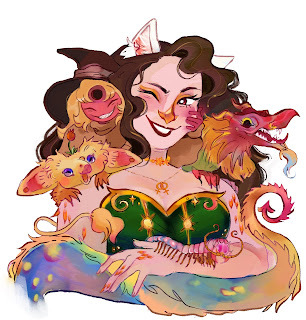
What’s next?
Book three. I’m currently thumbnailing it, which is probably the hardeststage because it’s when I compose every shot, similar to storyboarding a movie.
In book three, a school for magic is abducted, a wizard council isturned into puppets, a Prince is haunted, a giant corpse is reanimated, and anegg hatches. The culprit is right in front of you, but cannot be seen in amirror.
After that, maybe I will have something new to tell everybody about.
Where can we find you?
I have an author and art portfolio website at alizalayne.comand you can find all socials there as well. Thanks for the talk!
April 27, 2025
Filling in the February's Negative Space... (My Missed Post)
(This post was originally scheduled to present on February 28th, and most likely due to my tech ineptness, wasn't posted. Apologies to Holly and the others. I don't want you to think I'm slacking off.)
by Charlotte Bennardo
The theme is either finding our voice or world issues. Many of us are thinking that with the current world issues, our voice is lost in the cacophony of social media, fake or misleading news, and the vitriol from those who hold strongly opposite views.
It's overwhelming. We want to hide away.
 Photo by Vitaly Gorbachev: https://www.pexels.com/photo/a-man-in...
Photo by Vitaly Gorbachev: https://www.pexels.com/photo/a-man-in...Or refuse to listen to anymore.
 Photo by Monstera Production: https://www.pexels.com/photo/stressed...
Photo by Monstera Production: https://www.pexels.com/photo/stressed...Or be afraid to speak out.
 Photo by Anete Lusina: https://www.pexels.com/photo/young-wo...
Photo by Anete Lusina: https://www.pexels.com/photo/young-wo...
must be more abhorrent than our discomfort.
April 25, 2025
Whitespace (Holly Schindler)
In typography, whitespace (literally, the blank space surrounding type) can be a kind of negative space.
That whitespace can often help ensure clarity. Or it can create a mood. Maybe simple elegance.

In a broad sense, a chapter break can also be a form of whitespace. It offers readers a space, a pause, a breathing place. It's a break from type or graphics. It can help with clarity, too, as it allows readers a moment to take everything they've learned in this chapter and place it in their mental file folder.
Whitespace is a powerful tool.
So powerful, in fact, that I've been writing an entire series about chapter breaks on my Substack. I've been addressing types of breaks, the ways in which breaks heighten and release tension, how they manage time and POVs, and genre-specific considerations.
To follow along each Friday (when new posts release), subscribe here.
I'll be compiling all of this into a course when I'm done. To be notified of the release, subscribe here.
~
Holly Schindler is the author of The Junction of Sunshine and Lucky. She is also an editor and writing instructor.
April 24, 2025
For the Love of the Middle Grade Reader!
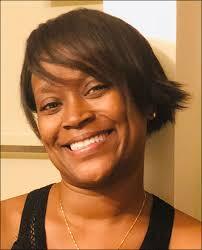
I’ve had the privilege of knowing Eileen Robinson for years.She has been a moving force in the publishing world for over three decades, as publisher, editor and teacher. As a masterteacher and editor, she has often collaborated with fellow master teachers andeditors, Harold Underdown and Emma Dryden, to teach courses through HighlightsFoundation. I’ve had the honor of working with Eileen on my new book, coming inSpring 2026. Recently we discussed her new imprint, Charlesbridge Move Books, andher philosophy that defines her life's work.
I’m so impressed and inspired by your philosophy behindCharlesbridge Move Books. Can you discuss this philosophy, and why/how itmatters to those of us who advocate for middle grade books, writers, teachers,librarians and parents?
I believe all of us who are drawn to making books, findingthem, and getting them into the hands of children want the same thing—toempower children and help them not only see themselves but others, too.
Middle grade readers are not preschoolers or teenagers. Theyare in that [elementary through middle school] gap where they are trying to understand their experiences and theadults around them. They are trying to form their own language to describe theworld they are in. They are silly and rambunctious, shy and adventurous, nerdyand cool, followers, as well as followed, reaching a bit for more independence,but needing to feel safe and loved, too. They are a mix of awkwardness thatlasts into their high school years. They are the readers.
They’ve learned to read and are fairly good at it(Charlesbridge Moves focuses on the reluctant reader). Now, it’s time to findsomething that echoes their experiences, that is meaningful to them. Charactersthey can relate to and cheer on. I think if you can empower children in thisage group to think for themselves, look at all sides, have their own thoughtsand opinions and share those in a healthy way, you end up with more criticalthinkers, and young people who weigh the options and think out of the box.Middle grade books help children through change, help them feel less alone inthe world while creating compassion and empathy whether they are exploring thefantastical, futuristic, or realistic.
As you noted, blending formats is very appealing forreluctant readers. I also sense that this blending of font, space and graphic elementsoffers readers a more immersive experience. Storytelling is all about thedramatization. What do you look for in amanuscript, as an editor and creator, when it comes to how you approach thisprocess of splicing font, space and graphic components?
Great question. I never really thought about it as aprocess. If I’m in love with the story, all kinds of things will bounce aroundin my brain as I’m reading. I can tell when a story just needs spot art or ifgraphic components might engage readers better. It may be the subject matter(DRAGONS) or specific genres that you know would make fantastic visuals—adventurousnovels lend themselves quite nicely. ButI always fight with how much to show—shouldn’t some of it be left to thereader? I don’t think there is a perfect formula. It’s quite subjective.
I love your discussion on banding together to amplifyvoices. That we’re all in this together. This sentiment is so much bigger than creatorshelping each other. It’s creators helping advocates helping readers, and viceversa. You talked about a conference in which young readers are in charge. What would that look like, and why/how is itimportant?
Honestly, I’m not sure what that really looks like yet, but Ithink kids would enjoy reading more if they had an opportunity to participatein a thoughtful but fun way. It’s two-way street. Yes, we are the educators, authors,illustrators, bookmakers, but when our books go out into the world, we rarely getto sit beside a child and see his first reactions, or hear what he thinks andwhy. Are the things a writer toiled over really that important, is a particularpiece of content—a word, and idea making the impact you think it does (good orbad)? And so on. You don’t get to feel the emotions breathing just beneaththeir skin or in their hearts. You don’t get to see when they smile, laugh, or cry.You can only hope you’ve touched someone in the way you intended. Do theyreally care about the trends? Well, the answer is probably yes, as sales willprove or disprove, but what about the kids that don’t? So getting a conferencefull of readers together—WOW!
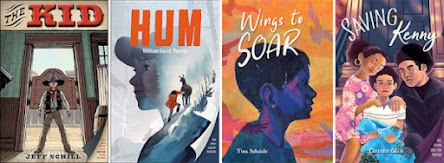 Recent Titles at Charlesbridge Move Books
Recent Titles at Charlesbridge Move Books
For more information on Eileen and her imprint, Charlesbridge Move Books,see the Publishers Weekly announcement, Eileen Robinson Brings Her Middle Grade Imprint to Charlesbridge (2024)!
Thank you, Eileen Robinson! And thank you for reading!
-- Bobbi Miller
April 23, 2025
The Presence of Absence: Smack Dab in the Imagination by Dia Calhoun
 Three Paintings Dealing With Grief
Three Paintings Dealing With GriefMonica Yother
At the Art Center College of Design, I first learned that the background or "negative space" around an image is as important a design element as the image. Translating this idea to writing, the negative space can be the following: the secondary or more unconscious psychological motivations driving (or hindering) the characters; the characters' backstories; and the larger historical, cultural, or archetypal conditions of the story's time, place, and setting.
All of this leads to an idea of mine that negative space is the presence of absence. Anyone who has lost a loved one knows all too well that grief is the howling presence of absence. The painting above by Monica Yother (used with permission) illustrates this beautifully.
Writers can access a character's negative space by imagining the negative space, maybe as a dark cloud, moving with and around the character. What is partly unknown by the character, but following them everywhere? What feeling tone does it have? Throbbing? Howling? Annoying? Angelic? This technique may help you discover new layers and depth in your character.




